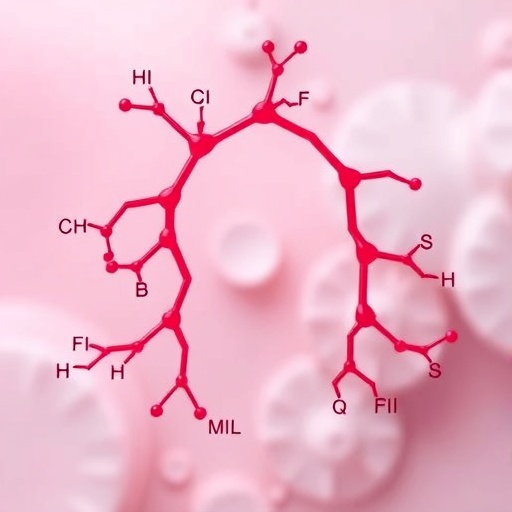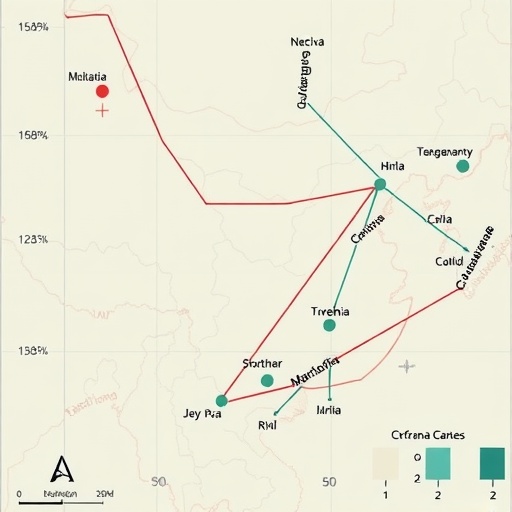
In the relentless quest to decipher the molecular intricacies underlying allergic rhinitis, a team of pioneering researchers has spotlighted a critical epigenetic mechanism that orchestrates immune responses and epithelial barrier integrity in the nasal mucosa. Their groundbreaking study unravels how METTL3-driven m6A RNA modification of a particular circular RNA, circCDKAL1, modulates macrophage polarization and nasal epithelial cell function, illuminating new therapeutic avenues for this pervasive and burdensome allergic condition.
Allergic rhinitis, characterized by chronic nasal inflammation induced by allergens, affects millions globally, significantly diminishing quality of life. Despite extensive research into immunological triggers and environmental factors, the detailed regulatory networks governing immune cell behavior and epithelial barrier function in this disease context remain incompletely understood. This novel investigation shifts focus onto the epitranscriptomic modification landscape—specifically m6A methylation—revealing its profound impact on inflammatory pathways and cellular crosstalk.
At the heart of the discovery is METTL3, a pivotal methyltransferase responsible for catalyzing the addition of N6-methyladenosine (m6A) marks on RNA molecules. These modifications influence RNA metabolism and function, underpinning diverse biological processes. In this latest study, METTL3’s activity on circCDKAL1, a circular RNA species resistant to exonucleases and distinct in its closed-loop structure, emerges as a key regulatory event. By mediating m6A modification, METTL3 alters circCDKAL1’s interaction with RNA-binding proteins, thereby affecting downstream signaling cascades.
Diving deeper into the molecular interplay, the researchers identified a sophisticated axis involving IGF2BP2, JARID2, and HMGB1 proteins. IGF2BP2, an m6A ‘reader’ protein, binds the methylated circCDKAL1, stabilizing it and facilitating the recruitment of epigenetic regulator JARID2. This complex, in turn, influences the expression of HMGB1, a chromatin-associated protein with well-documented roles in inflammation and tissue repair. Through this molecular relay, the study connects epitranscriptomic modifications to the orchestration of macrophage polarization and epithelial barrier dynamics.
Macrophages, the sentinel immune cells of the innate immune system, adapt their phenotype in response to environmental cues, transitioning between the pro-inflammatory M1 and anti-inflammatory M2 states. The study reveals that altered m6A modification of circCDKAL1 skews macrophage polarization favoring the M1 phenotype, which exacerbates inflammatory responses within the nasal mucosa. This shift underscores a mechanistic link between RNA modifications and immune cell functional plasticity, challenging previous understandings and suggesting novel intervention points.
Concurrently, the integrity of the nasal epithelial barrier, the frontline defense against environmental insults, is compromised when this axis is dysregulated. Disruption of this barrier not only facilitates allergen penetration but also perpetuates inflammation, creating a vicious cycle central to allergic rhinitis pathology. By restoring proper m6A modification patterns on circCDKAL1, the researchers could rescue epithelial barrier function, highlighting a potential strategy to fortify mucosal defenses.
The experimental approach encompassed cutting-edge molecular biology techniques, including RNA immunoprecipitation, methylated RNA immunoprecipitation sequencing (MeRIP-seq), and functional assays in macrophage and epithelial cell models. Through these methodologies, the team substantiated the causative role of METTL3-mediated m6A modifications in modulating the downstream IGF2BP2/JARID2/HMGB1 signaling axis, firmly establishing the mechanistic framework connecting epitranscriptomics to cellular phenotype and barrier physiology.
Importantly, this research extends beyond fundamental insights, carrying implications for therapeutic innovation. Targeting the METTL3-circCDKAL1 modification system, or its interaction with IGF2BP2 and downstream effectors, may provide selective means to temper pro-inflammatory macrophage activation and bolster epithelial resilience. This precision could transform allergic rhinitis management, shifting from symptomatic treatment to addressing root molecular dysfunctions.
Additionally, the findings add fresh layers to the expanding narrative on circular RNAs as crucial modulators in immune contexts. Traditionally overlooked as splicing by-products, circRNAs are increasingly recognized as central players in gene expression regulation. This study showcases how their epitranscriptomic landscape governs immune and barrier functions, a paradigm likely relevant in other inflammatory and autoimmune disorders.
The identification of JARID2’s involvement in this regulatory cascade is particularly captivating. As a known modulator of chromatin remodeling and gene expression, JARID2’s interaction within the axis hints at how transcriptional control intertwines with RNA modifications to dictate cell fate and function. This crosstalk exemplifies the intricate connectivity between epigenetic and epitranscriptomic layers in health and disease.
HMGB1’s role, a powerful alarmin and modulator of immune responses, anchors the axis to well-characterized inflammatory signaling networks. Its modulation through this newly discovered pathway suggests opportunities to manipulate known mediators of inflammation via upstream RNA modification targets, offering a multi-tiered approach to intervention.
The study’s authors emphasize the translational potential of their findings, advocating for further in vivo validation and the exploration of small molecules or biologics capable of modulating METTL3 activity or the m6A status of circCDKAL1. Such developments could pave the way for novel therapeutics that dampen allergic inflammation and restore nasal epithelial barrier function with high specificity.
In the broader context of RNA biology and immunology, this research exemplifies how advanced epitranscriptomic profiling can decode complex cellular communications governing disease states. As our toolkit for detecting and manipulating RNA modifications expands, so too will our capacity to develop next-generation immunomodulatory therapies.
Given the intricate interplay between environmental allergens, immune cell behavior, and epithelial architecture in allergic rhinitis, uncovering this epitranscriptomic axis provides a much-needed piece to the puzzle. It opens avenues not only for therapeutic innovation but also for biomarker development, enabling better diagnosis and disease monitoring based on RNA modification patterns.
This landmark contribution establishes a new frontier in allergy research, encouraging multidisciplinary approaches integrating molecular epigenetics, RNA biology, and immunology. The METTL3-circCDKAL1-IGF2BP2/JARID2/HMGB1 axis may soon become a cornerstone target for managing allergic rhinitis and potentially other mucosal inflammatory diseases.
As the field progresses, future studies might explore how environmental factors influence METTL3 activity and circCDKAL1 methylation, illuminating lifestyle or exposure-related modulation of disease severity. Moreover, the role of this pathway in other immune cell subsets and epithelial tissues will undoubtedly be an exciting area of investigation.
In sum, this study shines a spotlight on the transformative power of epitranscriptomic regulation in immune homeostasis and barrier function, reshaping our understanding of allergic rhinitis pathogenesis. It offers hope that by harnessing these molecular insights, clinicians may soon wield more effective and finely tuned tools against this ubiquitous and often underestimated condition.
Subject of Research: Epitranscriptomic regulation of macrophage polarization and nasal epithelial barrier function in allergic rhinitis.
Article Title: METTL3-mediated m6A modification of circCDKAL1 regulates macrophage M1 polarization and nasal epithelial cell barrier function in allergic rhinitis through IGF2BP2/JARID2/HMGB1 axis.
Article References:
Zhan, J., Luo, D., Fu, Y. et al. METTL3-mediated m6A modification of circCDKAL1 regulates macrophage M1 polarization and nasal epithelial cell barrier function in allergic rhinitis through IGF2BP2/JARID2/HMGB1 axis. Cell Death Discov. 11, 417 (2025). https://doi.org/10.1038/s41420-025-02710-7
Image Credits: AI Generated
DOI: https://doi.org/10.1038/s41420-025-02710-7
Tags: allergic inflammation pathwayschronic nasal inflammationcircCDKAL1 circular RNAepigenetic regulation of immune cellsepitranscriptomic mechanisms in allergiesimmune response regulationm6A RNA modificationmacrophage polarization in inflammationMETTL3 and allergic rhinitisnasal epithelial cell functionRNA methylation in diseasetherapeutic targets for allergic conditions




